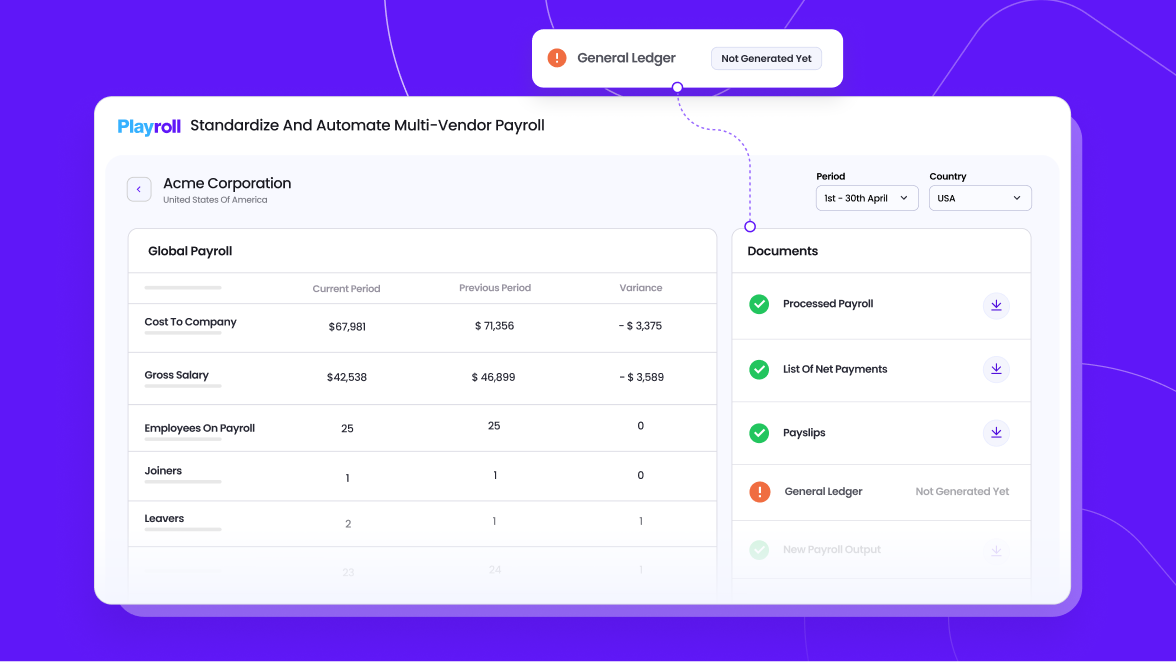Copied to Clipboard
Ready to get Started?


Key Takeaways
Retention is the real DEI metric. Recruitment gets talent in the door, but inclusion and belonging determine whether they stay.
DEI boosts performance and innovation. Companies with diverse teams are more profitable, more creative, and make better decisions faster.
Practical strategies matter. From bias training and ERGs to equitable pay and localized benefits, DEI only works when built into everyday systems and leadership.
Today, knowing how to promote diversity, equity, and inclusion (DEI) in the workplace is central to building a healthy, successful business. Gen Z now makes up 27% of the global workforce, and 76% of them say they’re more likely to stay with companies that actively practice DEI. That tells us something important: retention, not just recruitment, is the real measure of whether your culture is working.
Not long ago, workplace diversity was mostly about the hiring numbers, which in reality saw companies bringing in people from different backgrounds and hoping that would be enough. What really matters is what happens after people join: Do they feel included? Do they feel like their perspective matters? Do they want to stay?
This guide shares 10 practical ways to create an environment where individuality is celebrated, differences are respected, and people feel motivated to grow with you, not just join and leave.
The Benefits of Promoting Diversity and Inclusion
Building an inclusive culture means creating an environment where individuality drives innovation, loyalty, and long–term growth. Here’s what the numbers shows:
1. Innovation Flourishes When Perspectives Mix
When teams think differently, they challenge assumptions, open up new possibilities, and they generate real monetary results. A study by the Boston Consulting Group found that companies with diverse management teams earn 19% more of their revenue from innovation.
2. Diversity Strengthens the Bottom Line
Detractors of DEI initiatives suggest that they’re just too expensive to maintain. The research on the other hand, shows that investing in DEI is actually a competitive advantage.
McKinsey reports that organizations in the top quartile for ethnic and gender diversity are 36% more profitable than their less–diverse peers. Additionally, companies with above-average diversity scores drive 45% of their average revenue from innovation
3. Belonging Boosts Retention and Productivity
For as long as humans have existed, we’ve gravitated towards community. The workplace is no exception to that. It comes at no surprise that inclusive workplaces report 22% higher productivity and 39% better customer satisfaction. When people feel they belong, they stay – and they perform better.
4. Diverse Teams Make Smarter Decisions
When everyone around the table looks and thinks the same, blind spots multiply. But when you bring in people with different experiences and perspectives, the quality of decisions improves dramatically. Research shows that diverse teams make better business decisions up to 87% of the time. And when teams use an inclusive process, they move faster too, making decisions twice as quickly with half the number of meetings.
5. Inclusivity Is a Talent Magnet
A highly competitive global talent market and skills scarcity means that the best talent has options. Nearly 80% of workers want to work for a company that values diversity and inclusion. When 32% of job seekers won’t even apply if a company lacks diversity, your DEI initiatives can help you stand out in the market.
10 Effective Strategies to Promote Diversity and Inclusion in the Workplace
So apart from being the right thing to do, the numbers prove that investing in DEI is good for the bottom line. Use-case made and investors on board? Let’s get into how you can practically get started. Too often, organizations fail to create the conditions where diverse talent can succeed.
These 10 strategies are not quick wins or one-off initiatives. They’re about embedding systems, habits, and leadership behaviors that make diversity sustainable.
1. Call Out Bias Before It Calls the Shots
Bias is unfortunately not something we can switch off. It’s baked into how we process the world. In practice, unconscious bias shapes who gets hired, who gets promoted, and even whose ideas are heard in meetings. Left unchecked, it narrows your culture until everyone looks and thinks the same. The best way to avoid this is to recognize and call it out.
How to make progress:
- Start With Leaders: Encourage your leadership team to openly acknowledge their own blind spots. Vulnerability from the top sets the tone that growth is expected, not perfection.
- Make it Continuous: One-off “check the box” training doesn’t work. Invest in recurring bias workshops, book clubs, and scenario-based learning that evolve with the company.
- Create Reflection Points: After every hiring process, promotion round, or performance review, ask: where might bias have influenced outcomes?
- Keep it Anonymous: Use blind recruiting practices like removing names, schools, or photos from résumés so candidates are judged on skills first.
2. Policies That Actually Protect People (Not Just Paperwork)
Policies have the potential to be culture in writing. When they’re vague, hidden in handbooks, or never revisited, they send the message that inclusion isn’t a priority. But when policies are clear, accessible, and reinforced in practice, they tell your people: “We take your safety, individuality, and belonging seriously.”
How to build real policies:
- Cover More Than the Basics: Go beyond race and gender. Strong policies explicitly include religion, age, disability, sexual orientation, gender identity, and neurodiversity. The broader the coverage, the clearer the message that everyone is protected.
- Make Them Employee–Led: Don’t write policies in a vacuum. Use engagement surveys or feedback from ERGs to review and update them each year. When employees help shape the rules, they’re far more likely to trust and support them.
- Show What It Looks Like in Practice: Spell out what happens when someone raises a concern: how incidents are reported, how investigations are handled, and what resolution looks like.
- Make Them Accessible: Any anti-discrimination guidelines or zero-tolenance harassment rules for example, should be readily accessible to your team.
3. ERGs and Mentorship: From “Nice to Have” to Growth Engine
Without dedicated spaces for connection, employees from underrepresented groups can feel invisible. A simple way to encourage connection is to encourage your team to create Employee Resource Groups (ERGs). This is a voluntary, employee-led community group within an organization for people with shared identities, backgrounds, or experiences.
How to create connection:
- Back Them With Budget and Time: ERGs without resources are just lunch clubs. Give them funding, recognition, and actual time carved out of work schedules.
- Cross–Cultural Mentorship: Firstly, create a mentorship programme if you don’t have one. Then pair up employees across different demographics, seniority levels, or regions. This widens perspectives, builds empathy at scale, and helps people grow in ways no training program can.
- Integrate With Strategy: Bring ERG leaders into product reviews, hiring panels, and cultural initiatives. When employees see that their lived experience shapes the business and the culture, they’re more likely to stick around.
4. Hire for “Culture Add,” Not “Culture Fit”
“Culture fit” is often code for sameness. What you really want is “culture add”. This doesn’t mean you need to hire someone who’s radically different to your entire team, aligned values are important. But it does mean hiring people who bring new ideas, challenge assumptions, and stretch the company with new ways of doing things.
How to put this into practice:
- Rethink Job Ads: Use inclusive language that welcomes variety. Something as simple as swapping “native English speaker” for “fluent in English,” for example, opens up the door to qualified but more diverse candidates.
- Structure the Process: Standardize interview questions and use diverse panels to reduce “gut feeling” bias.
- Expand Globally: Partner with an Employer of Record like Playroll to hire in regions you might have dismissed as too compliantly complex. That’s how you tap into wider talent pools – and add unique perspectives you’d otherwise miss.
5. Holidays Matter: Show Up for What Your Team Values
If your holiday calendar only reflects one culture, employees notice. Recognizing cultural and religious holidays is one of the simplest and most powerful signals that individuality belongs at your company. You’re letting your team know that you acknowledge and respect their cultural and religious commitments.
Practical ways to show up:
- Global Holiday Calendars: Publish a shared calendar of cultural and religious observances across the regions where your team works. This avoids scheduling conflicts and shows proactive respect.
- Flexible Time Off: Offer floating holidays so employees can celebrate the events most meaningful to them, whether that’s Eid, Diwali, Lunar New Year, Yom Kippur, or Pride. One rigid calendar can’t possibly cover every tradition.
- Educate Through Celebration: Share stories about different traditions in newsletters, team Slack channels, or optional events. Keep it authentic and voluntary.
6. Talk Less, Listen More: Make Space for Honest Feedback
Part of creating a culture of inclusion is making sure that people feel comfortable and safe enough to speak up and confident enough that they’ll be taken seriously when they do. Listen to your team with intent and show them that feedback , where possible, will be met with some sort of action. You’ll be surprised at how much more engaged and motivated your team becomes.
How to build effective feedback loops:
- Normalize 1:1s and Retros: Hold them consistently, not just when something goes wrong. Use the time to talk about well-being and career growth, not only deliverables.
- Provide Anonymity Where Needed: Some employees will only share concerns when they feel protected. Pulse surveys, anonymous feedback forms, or digital suggestion boxes can surface issues you’d otherwise miss.
- Close the Loop: Feedback without follow-through erodes trust. If people raise issues, show what’s being done about them – whether that’s a change in process, clearer communication, or even acknowledging what can’t be fixed immediately.
7. Money Talks: Build Equity Into Salaries and Promotions
No amount of diversity celebrations or can cover up pay inequity. If employees see pay gaps or unfair promotions, trust evaporates instantly and it’s incredibly difficult to build back up again. The most important element of this entire process is transparency. Your team should understand how salaries are set, what criteria drive promotions, and how decisions are made.
Steps to get this right:
- Run Annual Pay Audits: Regularly compare salaries across demographics and fix inequities quickly. Don’t wait until employees raise the issue.
- Make Promotion Paths Transparent: Publish the criteria for advancement and apply them consistently. Hidden rules or moving goalposts undermine trust and block diverse talent from progressing.
- Standardize Globally: For distributed teams, tools like a global payroll manager make it easier to standardize and compare payroll processes across regions, in turn building fairer compensation globally.

8. Benefits That Work Everywhere
As a global employer, it’s important you recognize that one employee’s needs will be very different from another depending on where they live and what their daily lives entail. Meaning a one–size–fits–all benefits package designed around a single country or demographic will leave parts of your team feeling invisible. Health insurance might be the priority in one region, while in another, employees value parental leave, wellness stipends, or flexible childcare support.
How to make benefits equitable:
- Localize Packages: Offer what matters most in each market: healthcare in one country, parental leave in another, wellness stipends elsewhere. Benefits should reflect local realities.
- Ask, Don’t Assume: Survey employees about what they actually value most. For some, childcare support may matter more than gym discounts.
- Use Global Benefits Platforms: These tools make it easier to offer localized, competitive packages across multiple countries without taking on the compliance burden yourself.
9. Accessibility Is Inclusion in Action
Inclusion doesn’t mean much if some of your team can’t access the very tools, platforms, or spaces they need to do their jobs. You might think that accessibility means adding features for a minority, but really it means building systems that make life easier for everyone in your team.
What this looks like in practice:
- Physical Space Design: In offices, make sure spaces are easy for everyone to use: ramps instead of stairs, wide doorways, and desks that can be adjusted for height. For hybrid teams, use good cameras and microphones so remote employees feel like they’re part of the team.
- Flexible Environments: Create options that work for different needs: quiet areas for people who need focus, adjustable lighting for those sensitive to brightness, and workstations that can be set up comfortably for each person.
- Co-Created Solutions: Don’t guess what employees need. Form an accessibility group or task force, and invite people with disabilities or neurodiverse experiences to share what actually helps.
10. Leadership That Walks the Talk
Policies, ERGs, and benefits only go so far if leaders don’t model inclusive behavior themselves. Culture flows from the top and if leaders aren’t demonstrating the values they preach, employees won’t buy in.
How to make leadership inclusive in practice:
- Show Up Visibly: Join ERG events, acknowledge cultural holidays, and talk openly about the importance of diversity in company meetings. Employees notice when leaders are present (and when they’re not).
- Make Inclusion Visible in Decisions: When presenting strategies, highlight how diverse perspectives shaped the outcome. This connects leadership choices directly to DEI.
- Ask the Uncomfortable Questions: In hiring meetings, promotions, or product reviews, leaders should pause and ask: “Whose voice is missing here?”
- Share the Spotlight: Use leadership platforms (all-hands, investor calls, press) to showcase diverse talent and teams, not just executives.
- Measure Yourself: Leaders should set personal DEI goals (e.g., mentoring underrepresented talent, sponsoring ERGs) and report back publicly.
DEI Common Challenges & How to Solve Them
Global employers and HR leaders are navigating some very real roadblocks in diversity, equity, and inclusion (DEI). From backlash to budget cuts, the landscape is shifting, but the solutions are out there.
Here’s a quick breakdown:
How to Measure Success in DEI Efforts
It’s easy to launch DEI initiatives. It’s harder to know if they’re actually working. Too often, companies stop after the initial implementation: policies are written, ERGs are created, training is rolled out. But without clear measurement, no one knows whether those efforts are making a difference for employees day-to-day.
The Metrics That Matter:
- Representation vs. Industry Benchmarks: Track how your workforce compares to others in your sector and geography. Representation data helps you see where you’re doing well and where your pipeline may be missing voices.
- Pay Equity Across Demographics: Run regular audits to ensure people doing similar work are compensated fairly, regardless of gender, race, or background. Transparent pay equity is one of the strongest signals of an inclusive company culture.
- Promotion and Mobility Rates: Representation at entry level doesn’t mean much if diverse employees aren’t advancing. Measure who’s getting promoted, who’s moving laterally, and who’s being tapped for leadership opportunities.
- Belonging Scores From Surveys: Engagement or inclusion surveys can reveal whether employees feel comfortable speaking up, valued for their individuality, and supported to grow. Belonging is often the strongest predictor of retention.
- ERG Participation and Engagement: Track membership, activity, and influence of ERGs. Healthy participation shows employees see value in these communities, and leadership sponsorship demonstrates that you take their impact seriously.
Key Takeaways
Promoting diversity and inclusion in the workplace is about building a culture that retains individuality, not just one that hires it. When you tackle bias, design fair systems, and create space for different perspectives to shape decisions, you don’t just “check a box.” You build teams that are stronger, more innovative, and better equipped for long-term success.
And while the work of inclusion sits with leadership and HR teams, the right tools will make the process a little easier. From global hiring to payroll and benefits, Playroll can help you handle the operations so you can focus on creating a workplace where every person feels they belong. Book a demo with our team today to get started.
Diversity and Inclusion FAQs
What is diversity and inclusion?

.png)
Diversity refers to the presence of differences within a workplace. This can include visible characteristics like race, gender, age, and disability, as well as less visible ones such as socioeconomic background, sexual orientation, education, religion, and ways of thinking.
Inclusion is the active practice of creating an environment where those differences are respected, supported, and valued. It means building systems, policies, and everyday behaviors that ensure all employees have equal opportunities, resources, and decision-making.
How do you promote diversity and inclusivity in the workplace?

.png)
To truly create diversity and inclusion in your company, you need to go a step beyond hiring. Build culture: address bias, support ERGs, ensure pay equity, localize benefits, and create open channels for feedback.
Why is diversity and inclusion important?

.png)
Diversity and inclusion is important because diverse hires mean your business will perform better and be more profitable. And inclusion is important because diverse hires won’t stay without it. Retention, innovation, and performance come from cultures that embrace diverse perspectives and reward them.
.svg)
.svg)
.svg)

.svg)
.svg)






.png)


.png)

.svg)















.svg)